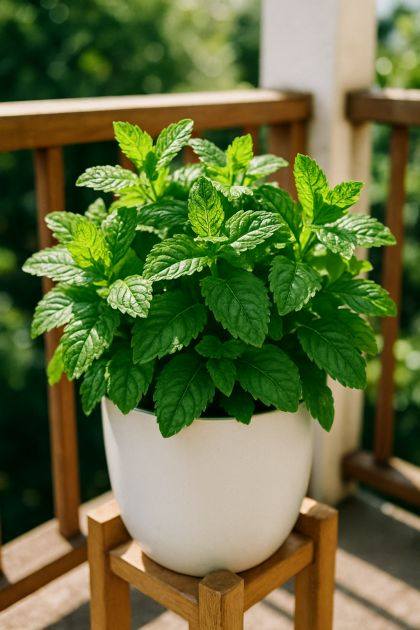Proper drainage is crucial to prevent water from accumulating at the bottom of the pot, which can lead to root rot. Ensure your pot has several drainage holes, and consider placing a layer of gravel or small stones at the bottom before adding soil. This layer will help facilitate drainage and prevent soil from blocking the holes.
Regularly check the drainage holes to ensure they are not clogged with soil or debris. If you notice water pooling on the surface or the pot feels heavy, it may be a sign that drainage is inadequate, and you should take steps to improve it.
5. Planting Mint Correctly
When planting mint, start by filling your pot with the prepared potting mix, leaving about an inch of space from the top. If you’re planting from a nursery-bought plant, gently remove it from its container and loosen any tightly bound roots. Place the mint in the center of the pot and fill in around it with soil, pressing gently to remove air pockets.
If you’re starting from seed, sow the seeds on the surface of the soil and cover them lightly with a thin layer of soil. Water gently to settle the soil and encourage germination. Mint seeds typically germinate in 10-15 days under optimal conditions.
6. Optimal Watering Techniques
Mint prefers consistently moist soil, but it should never be soggy. Water your mint plant when the top inch of soil feels dry to the touch. During hot weather, you may need to water more frequently, while in cooler months, watering can be reduced.
Watering in the morning is ideal as it allows excess moisture to evaporate during the day, reducing the risk of fungal diseases. Use a watering can with a narrow spout to direct water at the base of the plant, avoiding wetting the leaves, which can lead to mildew.
7. Provide Adequate Sunlight
Mint thrives in full sun to partial shade. Ideally, your mint plant should receive at least 4-6 hours of sunlight per day. If you’re growing mint indoors, place it near a south-facing window where it can receive ample light.
If natural light is insufficient, consider using a grow light to supplement. Mint can tolerate some shade, but too little light will result in leggy growth and reduced leaf production. Adjust the plant’s position as needed to ensure it receives adequate light.
8. Fertilize for Maximum Growth
To encourage robust growth, fertilize your mint plant every 4-6 weeks during the growing season with a balanced, water-soluble fertilizer. A 10-10-10 NPK fertilizer is suitable for mint, providing equal parts nitrogen, phosphorus, and potassium.
Be cautious not to over-fertilize, as this can lead to excessive leaf growth at the expense of flavor. If you prefer organic options, compost tea or fish emulsion can be used as natural fertilizers to promote healthy growth.
9. Prune Regularly to Encourage Bushiness
Regular pruning is essential to keep your mint plant bushy and prevent it from becoming leggy. Pinch back the tips of the stems regularly to encourage branching and fuller growth. Use clean, sharp scissors or pruning shears to make clean cuts just above a set of leaves.
Pruning also helps to remove any damaged or diseased leaves, improving air circulation and reducing the risk of pests and diseases. Aim to prune your mint plant every few weeks during the growing season for the best results.
10. Protect Against Pests and Diseases
Mint is relatively pest-resistant, but it can still fall victim to common garden pests such as aphids, spider mites, and whiteflies. Regularly inspect your plant for signs of infestation, such as discolored leaves or webbing. If pests are present, treat them with insecticidal soap or neem oil.
Diseases such as powdery mildew can occur if the plant is kept too wet or lacks air circulation. Ensure proper spacing and avoid overhead watering to minimize the risk. If mildew appears, remove affected leaves and improve air circulation around the plant.
11. Harvesting for Continuous Growth
CONTINUE READING ON THE NEXT PAGE 🥰💕

